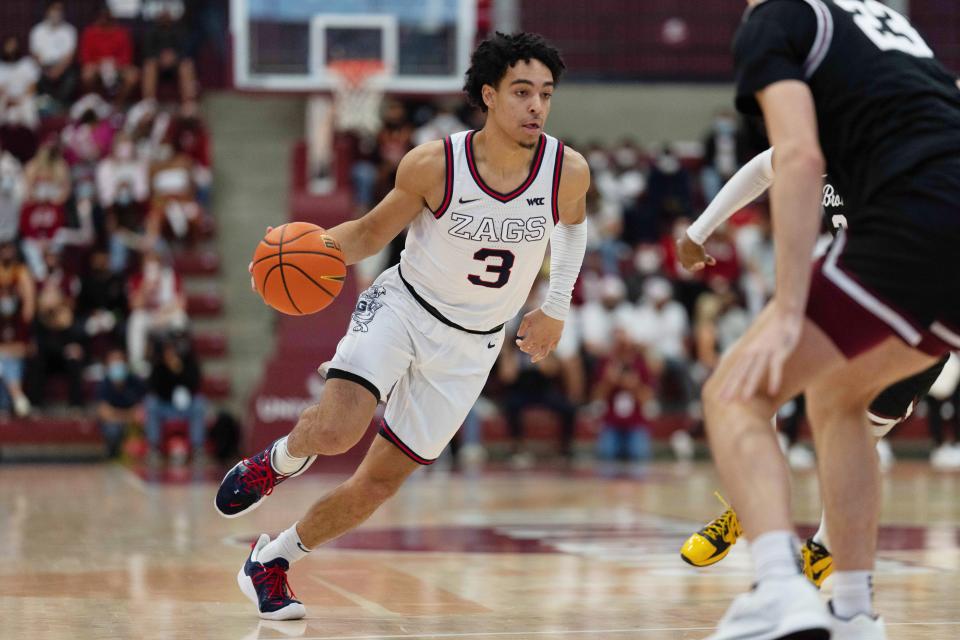Big 12 pursuit of Gonzaga no slam dunk amid internal pushback, financial questions
After he stuck the first shiv into the Pac-12, commissioner Brett Yormark said he was done making the Big 12 even bigger.
But Yormark, a basketball guy through and through who seems to enjoy being a college sports disruptor, just can’t resist Gonzaga shooting their shot. The question for the Big 12 is whether it’s a slam dunk or a wild half-court heave.
As The Messenger first reported on Monday, Yormark has indeed resumed talks with Gonzaga to join as a men's basketball member (along with other non-revenue sports) and recently pitched the league’s decision-makers about adding them for 2024-25 if possible, three people with knowledge of the discussions told USA TODAY Sports.
Those people spoke on the condition of anonymity because they were not authorized to comment publicly on the matter.
It’s unclear exactly how far down the road the negotiations have gotten, and there is certainly internal pushback among several Big 12 administrators about adding another high-level men’s basketball program to an already loaded league that beginning next season will include perennial national title contenders like Kansas, Arizona, Baylor and Houston as well as frequent NCAA men's tournament participants Kansas State, TCU, Iowa State, BYU, West Virginia and Oklahoma State.

Gonzaga, located in Spokane, Washington, and not particularly close to any major airports, would also increase the travel burden to an already far-flung league that will stretch from Orlando to Salt Lake City. One person briefed on the situation said Yormark has work to do to get the necessary support for adding Gonzaga.
What’s clear is that Gonzaga wants into the Big 12 and will accept significant financial concessions to make it happen. This would be similar to how SMU pursued membership in the ACC, ultimately agreeing to take no conference television revenue for nine years.
What’s not so obvious is whether this would be a good business move for the Big 12 or a pure vanity project for Yormark, who spent much of his career working for the Detroit Pistons and Brooklyn Nets and has been vocal about his belief that college basketball is an undervalued asset with significant growth potential.
After Yormark successfully added Colorado, Utah, Arizona and Arizona State this past summer — wrecking the Pac-12 and bringing the Big 12’s membership to a nice, round 16 — it seemed the book was closed on further expansion.
But Yormark’s fascination with Gonzaga never went away.
One way to look at it: If Yormark believes there’s potential to grow revenue by separating the media deals for football and basketball in the next round of negotiations in 2029, Gonzaga is arguably the best basketball property not currently attached to a major conference.
The question being asked within the Big 12, though, is what that would really mean to the bottom line, especially when you’re asking schools to travel another 550 miles further from the league’s new northwestern boundary in Utah. Those answers have not come yet, at least in terms of hard projections and commitments from the television networks.
Is Gonzaga going to significantly increase TV revenue in the future? How is it going to change the math on number of NCAA tournament bids? And is Gonzaga positioned to be a long-term fit in a league like the Big 12 when its success as a national brand has taken place in a unique context in the West Coast Conference and with a coach in Mark Few who has stayed in place since 1999.
In other words, is Gonzaga going to still be this big prize for a football-oriented league like the Big 12 once Few, who will turn 61 later this year, eventually retires? The American Athletic Conference tried something like this when it added Wichita State as a pure basketball play during its apex under Gregg Marshall. But Marshall is now gone and Wichita State has not exactly pulled its weight in the league, with two NCAA tournament appearances and no wins in six years.
Yormark’s deft handling of the television negotiations last year and successful pursuit of the so-called “Four Corners” schools from the Pac-12 has given him great credibility among the Big 12’s decision-markers. And he seems convinced that there’s financial potential in that marriage, especially at a discount rate, which means the presidents are taking it seriously.
But Yormark’s fundamental theory that college basketball has significant untapped potential is unproven, at best.
Television ratings for regular season games on CBS over the last four years have averaged between 1.2-1.3 million viewers while the number rages from 765,000 to just under 1 million on ESPN and FOX. Those aren’t insignificant numbers, but college basketball has struggled to penetrate outside its core fan base until March Madness when it rises to the top of the food chain for a month.
Can the Big 12 change that dynamic? And can Gonzaga help the Big 12 do it? There's some data to suggest pitting Gonzaga against the Big 12's current heavyweights will have a positive impact on ratings. But translating that to a huge media deal centered around basketball in 2030 is highly speculative, at best.
Yormark apparently believes it's worth a shot. We’ll see whether he can convince the league’s decision-makers to come along for the ride.
This article originally appeared on USA TODAY: Big 12 pursuing Gonzaga expansion but faces pushback over finances
